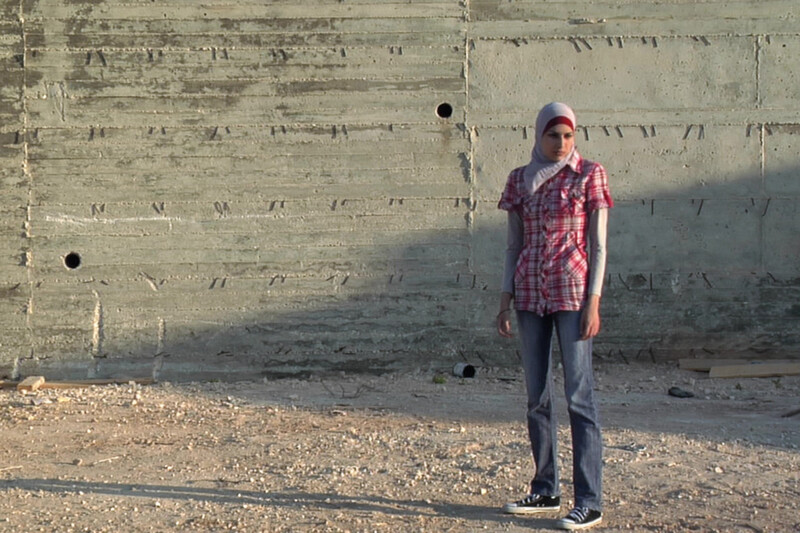The Electronic Intifada London 24 December 2012

Two Meters of This Land leaves much open to interpretation. (Film still courtesy of Ahmad Natche)
A man and a woman are in a production studio preparing a TV segment, sifting through old black-and-white photos of the Palestinian revolution. The woman, from France, displays a certain ignorance, but Raouf, whose face the viewer never quite sees, is polite. Later, she asks him to attend one of her meetings as a translator, but he declines, saying he is busy.
Teenagers from the dance troupe El-Funoun (a real group) sit around gossiping and stretching, while technicians set up a sound stage for a music festival and musicians tune their instruments.
A student journalist fumbles her ancient tape recorder during an interview.
Giant keys, the symbol of the right of the Palestinian refugees to return to the homes from which they were expelled in 1948, sit around as neglected props.
Some of these scenes from Two Meters of this Land threaten to develop into a plot but none do so.
Mesmerized
Palestinian-Spanish director Ahmad Natche’s stunning debut feature film is difficult to take your eyes off. Despite very little happening, there is so much that could be said. But it is left between the lines of the script.
If there was a script. The actors were apparently non-professionals, and it looks to have been partly improvised. According to the filmmakers, the independent film is possibly the only 2012 feature to have been produced and shot in the West Bank or Gaza. Post-production was possible thanks to a “crowdfunding” campaign launched on the Internet. A real music festival was the film’s set, according to Natche (“Two Meters of this Land: an interview with a Palestinian director,” Mena Muse, 24 December 2011).
Nothing much really happens, but still, you are mesmerized. This is largely down to the brilliant cinematography. With insightful composition, many of the most lingering shots are like artworks in themselves.
Paradoxically, there is an almost visceral excitement. There is so much meaning in the everyday.
Humanity
It’s not a particularly political film, but in a way, it does address certain issues. For example, Noemi, the French character, seems to have been hired as something of an expert and certainly seems to be in a position of (minor) authority.
Yet it is revealed in another scene that she did not even know most Palestinians are barred from traveling to Jerusalem. How could she not?
Portraying the humanity of the everyday lives of Palestinians beyond media cliché is a sort of political act in itself.
There is one scene in which a survivor of the Nakba, Israel’s 1948 ethnic cleansing of Palestine, tells parts of her story. But we hear just bits of a narrative. Her friend, off-camera, interrupts her several times to correct her.
The section concludes with a shot back in the now-empty production studio, and we see the interview with the Nakba survivor on a monitor. The scene we just saw turns out to be the unedited rushes of a Palestinian TV segment or documentary.
Or so it seemed to me. Part of the beauty of this film is that, like so much good art, it leaves much open to interpretation.
Familiar scenes
There are also scenes which anyone who has spent a little time living in the West Bank will recognize. A photographer speaks in Arabic to one of the technicians, teaching him a few words of Japanese (and her Arabic is very good).
The film’s title comes from a poem by the late Mahmoud Darwish, “Mural”:
Two meters of this land are enough for now.
A meter and seventy-five centimeters are enough for me.
The rest is for a chaos of brilliant flowers to slowly soak up my body.
Darwish wrote here about what would happen to his body after his death. The final scene takes place at his grave, where two of the dancers have absconded, bored with all the waiting.
A boy reads the last section of the poem to a girl and, for a moment, another potential plot looms. But viewers are ultimately left to fill in this gap themselves, and the film is all the richer for it.
Asa Winstanley is a journalist from London who has lived and worked in occupied Palestine.






Comments
Palestinian film
Permalink Karen Nakamura replied on
I love it if everyone reading this who isn't already aware to explore the incredible photos/films/artwork/music coming from Palestinian artists.